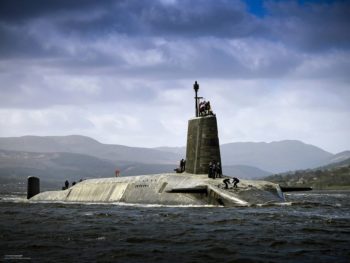 Royal Navy Vanguard Class submarine HMS Vigilant (Defence Images)
Royal Navy Vanguard Class submarine HMS Vigilant (Defence Images)
UK Nuclear Expansion Highlights Need for Renewed Focus on Non-Proliferation
In the United Kingdom, Prime Minister Boris Johnson recently made the policy decision to expand the cap on its nuclear arsenal by over forty-percent, from 180 to 260 nuclear warheads. The decision comes after an “integrated security review” by the UK government which deemed the nation to be facing a significant enough risk from hostile actors to make increased deterrence necessary. This decision by the UK government not only harms the legitimacy of the Treaty on the Non-Proliferation of Nuclear Weapons (NPT), but also highlights the need for a significant change in the global nuclear security infrastructure and renewed nonproliferation leadership. Arms control efforts should begin to incorporate more multilateral efforts towards reduction and set real limits on all aspects of nuclear arsenals and related delivery systems.
Like the United States, the United Kingdom has a long history behind its nuclear arsenal. Currently, the UK possesses the fifth largest nuclear arsenal in the world—behind the U.S., Russia, France, and China. The integrated security review says that while the government stated an intent in 2010 to reduce its overall nuclear warhead stockpile from 225 to 180 by the mid 2020’s, the evolving security environment means this is no longer possible and the UK will extend the ceiling to 260 warheads. The commitment made in 2010 to limit warheads represented progress for global nonproliferation, especially coming from one of the five nuclear powers enumerated in the NPT. However, the UK’s policy reversal threatens the eventual realization of one of the three pillars of the NPT: disarmament. Additionally, the security advantage gained by the addition of 35 warheads is negligible compared to the damage these types of policies have on the progress of nuclear security.
The world needs strong leadership on nuclear nonproliferation if there is to be significant progress toward arms reduction, whether it be in the form of nuclear summits or taking the plunge into complete disarmament. Currently, the conversation is stagnant and has slowly been relegated to academics, international organizations, and non-nuclear states. A country such as the UK is a perfect example of a potential leader in nonproliferation and it is in a uniquely qualified position to lead the charge on disarmament, rather than doubling down on its nuclear stockpile. The UK sits comfortably under the umbrella of U.S. extended deterrence—if there is a threat grave enough to warrant the UK’s nuclear retaliation, the same threat will likely be faced by the U.S. as well. The sentiment of reduction is already in UK government, as evidenced by a previous attempt to reduce the warhead cap, it has strong allies to bolster its national security, and the UK is a global power that would be difficult to ignore should it begin to make waves.
In the coming years, the world is going to see monumental advancements in nuclear warheads, missile defense, and delivery vehicles. The discussion on nuclear weapons will turn to quality and not quantity. Russian hypersonic glide vehicles alone are changing the rules of the game for strategic deterrence. In addition, space is becoming the latest arena where Russia, China, and the U.S. are already preparing warfighting capabilities.
The next step for international nuclear security should begin with multilateral talks on the future of arms control. The New START bilateral treaty has so far been successful in constraining the arsenals of the U.S. and Russia, but the U.S. should strive to expand beyond bilateral agreements without putting the arms control regime with Russia at risk.
Additionally, as technology changes and other countries begin changing strategy, the solutions must change as well. Advancements in delivery vehicles and warheads are already making simple numerical comparisons obsolete. The future of arms control will need to incorporate all nuclear powers and address not only stockpile ceilings, but detailed limitations on missile technology, yield size, and even orbital platforms. Well-rounded multilateral treaties could set reduction goals based on percentage to span the gap between varying arsenal sizes, similar to that of tax brackets, and limitations on technology that work to put countries on the same playing field. As the UK begins its nuclear expansion, the need for leadership and significant change in the global nuclear security regime is highlighted, perhaps this development will spark a conversation.
“HMS Vigilant” by Defence Images is licensed under CC BY-NC 2.0





